How to independently make and install a deflector in the chimney of a heating boiler
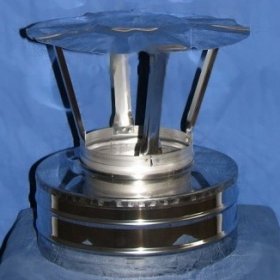
An integral and very important part of the heating system is the chimney. The device is designed to divert toxic combustion products into the atmosphere. The efficiency of the boiler depends on its proper functioning. The draft resulting from the differences in pressure and temperature inside the chimney must be sufficient, otherwise the design will not be able to cope with its functions. To reduce the negative impact of wind on draft and protect the channel from rain and debris, a chimney deflector is used. We suggest you talk in more detail about how it works and how to carry out its installation.
What is a deflector and how does it work?
Deflectors are devices installed in the ends of chimneys. Their main purpose is to increase traction in the flue channel. There are a large number of different models of the device, but the principle of operation is the same for everyone. The draft in the chimney is enhanced by the deviation of the air flow. When air flows around an obstacle, which is a deflector, a low pressure zone occurs. The pressure difference inside the channel increases, respectively, the thrust improves.

Airflow hits the deflector and bends around it. Jets of air glide over the surface of the device and penetrate inward, drawing in smoke from the flue duct
According to experts, the use of the device increases the intensity of the air flow inside the chimney to 20%. The increase in traction is clearly noticeable in structures with several bends. Especially strong winds usually blow into the pipe and prevent the exhaust gases from escaping. The so-called "Tipping" tractionwhen the combustion products, not finding an outlet to the atmosphere, enter the room. The deflector helps to cope with this dangerous phenomenon, using wind power to improve draft in the chimney.
A standard device can be divided into three components:
- The lower cylinder is made of ceramic, metal or asbestos-cement pipe.
- Diffuser or top glass. It has an expanding downward shape, is attached to the lower cylinder using special racks.
- Umbrella in the form of a cone-shaped cap.
To deflect the wind, annular rebounds are installed in the upper part of the diffuser and the lower glass. The best material for the deflector is galvanized steel, since the device has to function in adverse conditions. During installation, the device is positioned so that wind of any direction does not impede the exit of combustion products, but, on the contrary, helps them to rise upward, pulling them through the lower or upper annular space.
The principle of operation of the device is quite simple. The air flow hits the walls of the upper cylinder and bends around it. Part of the air jets glides over the surface and, turning up, draws in smoke that comes out of the chimney.Thus, wind blowing not in the horizontal direction contributes to an increase in traction. However, when the downwind blows, vortices form inside the hood that prevent smoke from escaping. This is the main disadvantage of the deflector. However, you can get rid of it if you install an additional reverse cone under the umbrella, which will help to reflect the air currents, cut them, and then bring them out.
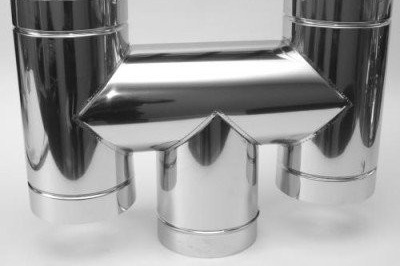
Many different chimney deflector options are available. The picture shows an n-shaped design that works very well in areas where gusty winds often blow
There are many device options. The most common: Grigorovich’s deflector, n-shaped design, round “Volper”, reminiscent of the “Shenard” star in shape, open Astato, TsAGI and others.
Note! Deflectors are installed on the chimneys of solid fuel boilers; it is forbidden to mount it on the chimney of a gas boiler. You can find confirmation of this in SNiP II-35 and SNiP 2.04.05 “Installation of smoke and ventilation channels”. This is due to the fact that in the cold season, ice can form on it, which impedes the normal operation of the heater.
Independent manufacture and installation of the deflector
If desired, the simplest version of the device can be performed independently.
Stage # 1 - calculation of the dimensions of the structure
Before proceeding with the manufacture of the device, it is necessary to carry out calculations and perform a drawing. Calculations are based on the size of the internal diameter of the chimney. The height of the deflector should be equal to 1.6-1.7 of this value, the width of the diffuser - 1.2-1.3 and the width of the cap - 1.7-1.9. These proportions suggest the most efficient operation of the device. Based on the obtained dimensions, we construct a drawing of the deflector elements. You can execute it on cardboard, thus obtaining patterns for cutting parts.
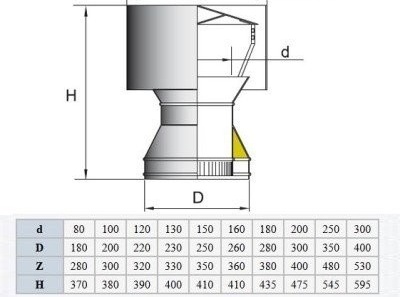
The device proportions can be calculated as described above or take values from the table (click to enlarge)
Stage # 2 - manufacture of the device
The prepared patterns are laid on metal and circled along the contour. We carefully cut out all the elements with metal scissors. Using rivets, small bolts or welding we connect all the parts. We make brackets from a metal strip on which the cap will be mounted. We install them on the outer surface of the diffuser. We fix the reverse cone to the umbrella. After all the main parts are prepared, you can proceed to assemble the device in the chimney.
Stage # 3 - installation of the finished product
We install the lower cylinder on the chimney and fix it with a bolted connection. Using a clamp, we attach a diffuser or upper cylinder to it. Then we fix the umbrella cap and the reverse cone to the brackets, which will allow the deflector to perform its functions, even if the downstream wind blows. Installation is complete.
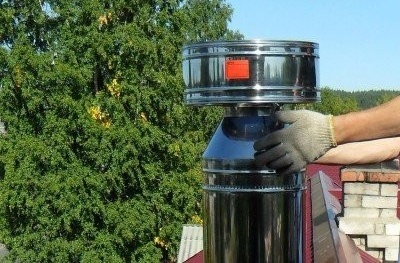
If the flue channel is large in diameter, then for reliable fastening of the device we use additional extensions made of steel wire
Adequate draft in the chimney is the key to the normal operation of the heater. To improve and stabilize it, various devices are used. They can be purchased in specialized stores or made independently. So the do-it-yourself deflector for the chimney is made without much difficulty. A properly installed device will significantly increase the efficiency and safety of the heating system.
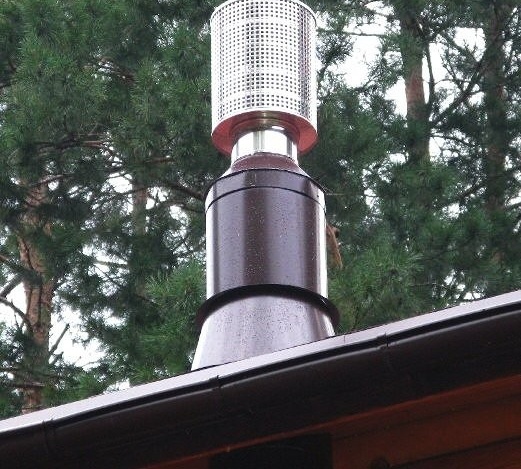
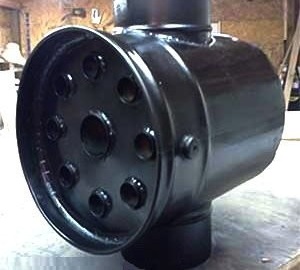
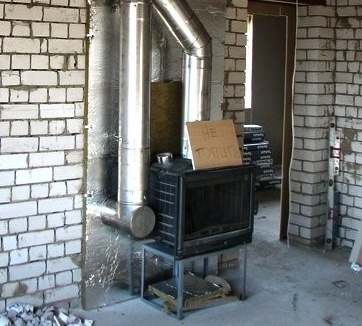
1 comment